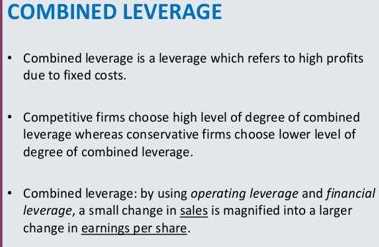Degree of Combined Leverage Definition and Formula

The degree of combined leverage is a financial ratio that measures the sensitivity of a company’s earnings per share (EPS) to changes in sales. It is used to analyze the impact of changes in sales on a company’s profitability.
The formula to calculate the degree of combined leverage is:
- Degree of Combined Leverage = Operating Leverage x Financial Leverage
Operating leverage measures the fixed costs of a company, while financial leverage measures the use of debt to finance operations. By multiplying these two leverages together, we can determine the overall impact of changes in sales on a company’s EPS.
A higher degree of combined leverage indicates that a company has a higher sensitivity to changes in sales. This means that small changes in sales can have a significant impact on the company’s profitability. On the other hand, a lower degree of combined leverage indicates that a company is less sensitive to changes in sales.
To calculate the degree of combined leverage, you need to know the company’s operating leverage and financial leverage. Operating leverage can be calculated using the following formula:
- Operating Leverage = Contribution Margin / Operating Income
Financial leverage can be calculated using the following formula:
- Financial Leverage = Total Assets / Total Equity
Once you have calculated the operating leverage and financial leverage, you can multiply them together to find the degree of combined leverage. This ratio will give you an indication of how sensitive a company’s earnings per share are to changes in sales.
The degree of combined leverage is a financial ratio that measures the sensitivity of a company’s earnings before interest and taxes (EBIT) to changes in sales. It provides insights into the company’s operating leverage and financial leverage, which together determine the overall risk and profitability of the business.
Operating leverage refers to the use of fixed costs in a company’s operations. These fixed costs, such as rent, salaries, and depreciation, do not change with the level of sales. As a result, a company with high operating leverage will have a higher proportion of fixed costs in its cost structure.
Financial leverage, on the other hand, refers to the use of debt to finance a company’s operations. By taking on debt, a company can amplify its returns when sales are increasing. However, it also increases the risk of financial distress if sales decline.
The degree of combined leverage combines both operating leverage and financial leverage to provide a comprehensive measure of a company’s risk and profitability. It is calculated by dividing the percentage change in EBIT by the percentage change in sales.
A high degree of combined leverage indicates that a company has a higher risk and potential for profitability. This is because a small change in sales can have a significant impact on the company’s earnings. Conversely, a low degree of combined leverage suggests that the company has a lower risk and potential for profitability.
Investors and analysts use the degree of combined leverage to assess the risk and profitability of a company. It helps them understand how changes in sales can affect the company’s earnings and make informed investment decisions.
Calculating the Degree of Combined Leverage
The degree of combined leverage (DCL) is a financial ratio that measures the sensitivity of a company’s earnings before interest and taxes (EBIT) to changes in sales. It is a useful tool for evaluating the financial risk associated with a company’s capital structure.
To calculate the DCL, you need to know the company’s fixed costs, variable costs, and sales. The formula for DCL is as follows:
Let’s break down the formula step by step:
1. Calculate the contribution margin, which is the difference between sales and variable costs. This represents the amount of revenue that contributes to covering fixed costs and generating profit.
2. Calculate the degree of operating leverage (DOL), which measures the sensitivity of EBIT to changes in sales. The formula for DOL is:
DOL = (Sales / EBIT)
3. Divide the fixed costs by the contribution margin to calculate the degree of financial leverage (DFL), which measures the sensitivity of earnings per share (EPS) to changes in EBIT. The formula for DFL is:
DFL = (Fixed Costs / Contribution Margin)
4. Finally, multiply the DOL by the DFL to calculate the DCL:
DCL = DOL * DFL
By calculating the DCL, investors and analysts can assess the potential impact of changes in sales on a company’s profitability and make informed decisions about its financial health and stability.

Emily Bibb simplifies finance through bestselling books and articles, bridging complex concepts for everyday understanding. Engaging audiences via social media, she shares insights for financial success. Active in seminars and philanthropy, Bibb aims to create a more financially informed society, driven by her passion for empowering others.
